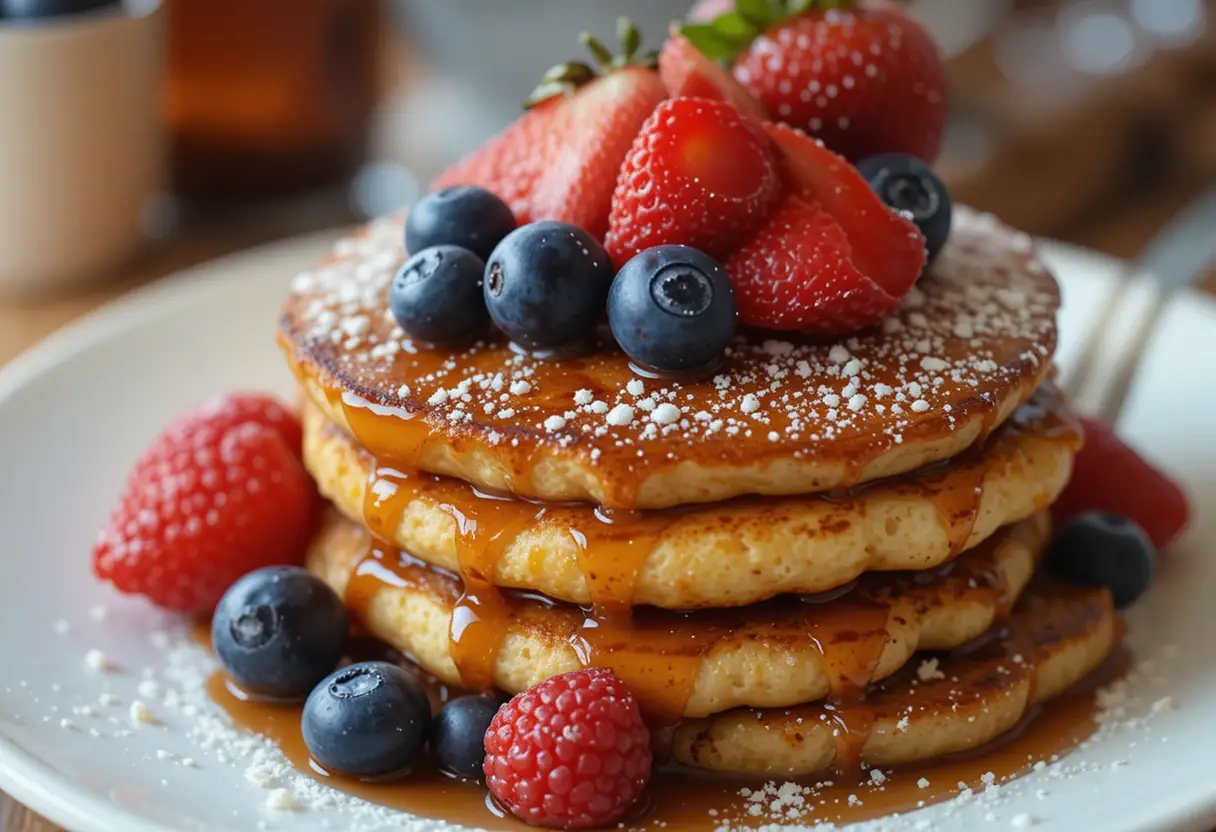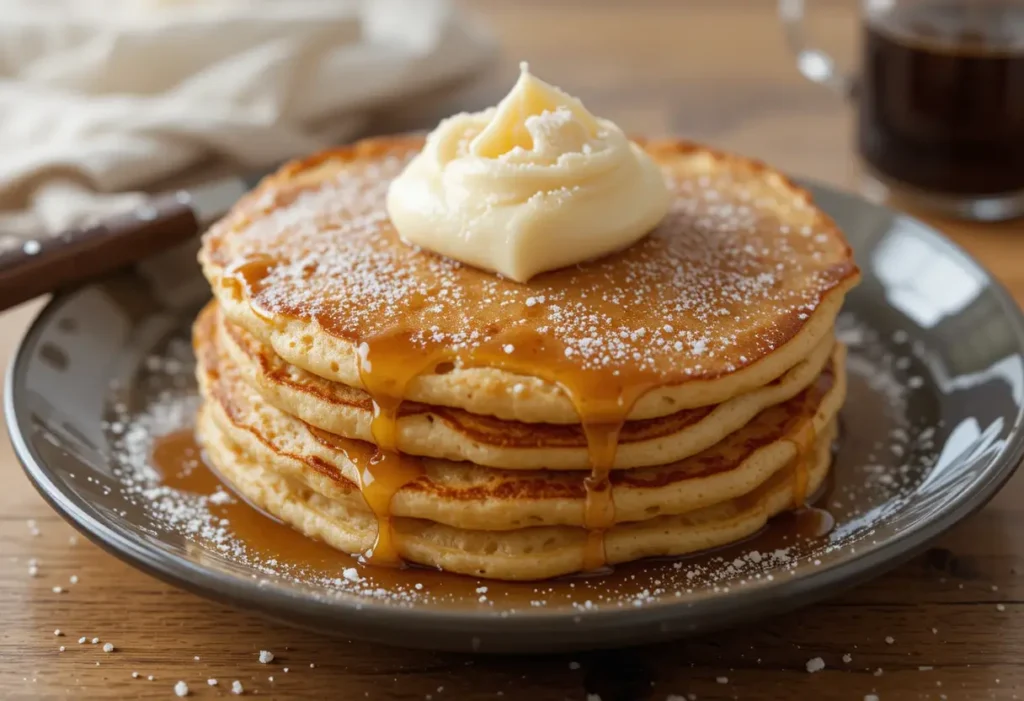If you’re a fan of both French toast and pancakes, get ready to experience a delicious combination of these two breakfast favorites. French toast pancakes merge the rich, eggy flavors of French toast with the fluffy, tender texture of pancakes, creating a breakfast delight that’s as satisfying as it is unique. This guide will walk you through everything you need to know to master this fusion dish.
What Makes French Toast Pancakes Unique?
French toast pancakes stand out for their delightful blend of textures and flavors. Unlike traditional pancakes, which are primarily fluffy and cake-like, French toast pancakes are infused with a custardy richness, thanks to their egg-based batter. The addition of cinnamon, vanilla, and a touch of sugar enhances the flavor profile, making each bite reminiscent of classic French toast.
The History of French Toast and Pancakes
Both French toast and pancakes boast rich histories as beloved breakfast staples. French toast, known in some regions as “pain perdu” or “lost bread,” originated as a way to use up stale bread by soaking it in a mixture of eggs and milk before frying. Pancakes, on the other hand, date back to ancient civilizations, where they were made using basic ingredients like flour, water, and eggs.
The fusion of these two dishes into French toast pancakes is a modern culinary innovation, offering a creative twist on classic breakfast traditions.
Ingredients Needed
Essential Ingredients for French Toast Pancakes
To prepare a delightful batch of French toast pancakes, gather the following ingredients in these quantities:
- 1 ½ cups all-purpose flour – Provides the structure and base for the pancakes.
- 2 large eggs – Contributes to the custard-like richness and helps bind the ingredients.
- 1 ¼ cups milk – Adds moisture and ensures a smooth batter consistency.
- 2 tablespoons sugar – Sweetens the batter lightly.
- 1 teaspoon ground cinnamon – Infuses the batter with warm, spicy undertones.
- 1 teaspoon vanilla extract – Enhances the flavor and adds a subtle aroma.
- 1 tablespoon baking powder – Ensures the pancakes rise and become fluffy.
- ¼ teaspoon salt – Balances the sweetness and enhances the overall flavor.
- 2 tablespoons butter or oil (for cooking) – Prevents sticking and adds a golden finish.
Optional Add-ons for Enhanced Flavor
Customize your French toast pancakes with these optional ingredients:
- Maple syrup (as desired) – For drizzling over the pancakes to add sweetness.
- Powdered sugar (1–2 teaspoons, for garnish) – A light dusting for visual appeal and additional sweetness.
- Fresh fruits (½ cup, such as berries, bananas, or sliced apples) – Adds a fruity twist and freshness.
- Whipped cream (as desired) – For a rich and indulgent topping.
- Chopped nuts (¼ cup, such as pecans or almonds) – For added texture and crunch.
- Chocolate chips (¼ cup) – A decadent addition for chocolate lovers.
- Spices (a pinch, such as nutmeg or cardamom) – For extra warmth and complexity in flavor.
With these precise quantities, you’re all set to create the ultimate French toast pancakes tailored to your taste preferences!
Step-by-Step Recipe
Preparing the Batter
- Gather Ingredients: Collect all the essential ingredients and measure them accurately to ensure consistency.
- Mix Dry Ingredients: In a large mixing bowl, combine 1 ½ cups of all-purpose flour, 2 tablespoons of sugar, 1 tablespoon of baking powder, 1 teaspoon of ground cinnamon, and ¼ teaspoon of salt. Whisk together to blend evenly.
- Prepare Wet Ingredients: In a separate bowl, beat 2 large eggs, then whisk in 1 ¼ cups of milk and 1 teaspoon of vanilla extract until smooth.
- Combine Wet and Dry Ingredients: Gradually pour the wet mixture into the dry ingredients, stirring gently with a whisk or spatula. Mix until just combined; the batter should be slightly lumpy to ensure fluffy pancakes.
- Let It Rest: Allow the batter to rest for about 5 minutes. This step helps the baking powder activate and ensures a light, airy texture.
Tips for the Perfect Flip
- Preheat the Pan: Heat a non-stick skillet or griddle over medium heat. Add a small amount of butter or oil and let it melt evenly.
- Portion the Batter: Use a ladle or measuring cup to pour batter onto the hot surface. Aim for about ¼ cup of batter per pancake to achieve a uniform size.
- Look for Bubbles: Wait until small bubbles form on the surface of the pancake, and the edges begin to set (about 2–3 minutes). This indicates the pancake is ready to flip.
- Flip Gently: Use a spatula to carefully lift the pancake and flip it in one smooth motion. Avoid pressing down on the pancake after flipping, as this can make it dense.
- Avoid Overcrowding: Cook 2–3 pancakes at a time to maintain control and ensure even cooking.
Cooking and Timing Techniques
- Adjust Heat as Needed: Maintain medium heat to cook the pancakes evenly without burning. Lower the heat slightly if the pancakes brown too quickly.
- Cook the Second Side: After flipping, cook the second side for another 1–2 minutes until golden brown. The center should be cooked through.
- Keep Warm: Place cooked pancakes on a plate and cover with foil to keep them warm while finishing the rest.
- Serve Fresh: French toast pancakes taste best when served immediately. Top with your favorite add-ons, like fresh fruit, syrup, or whipped cream.
By following these steps and tips, you’ll achieve perfectly cooked French toast pancakes every time!
Nutritional Information
Caloric Breakdown of French Toast Pancakes
A standard serving of French toast pancakes (approximately three medium-sized pancakes) contains the following:
- Calories: 250–300 (without toppings)
- Protein: 6–8 grams (from eggs and milk)
- Carbohydrates: 35–40 grams (from flour and sugar)
- Fats: 8–10 grams (from eggs, butter, or oil)
- Fiber: 1–2 grams (depending on flour type and optional ingredients like fruits or nuts)
- Sugars: 6–8 grams (natural sugars and added sugar)
Toppings like syrup, whipped cream, or chocolate chips can add additional calories and sugar.
Healthier Substitutes for Traditional Ingredients
- Flour: Swap all-purpose flour for whole wheat flour or almond flour to increase fiber and nutrients.
- Sugar: Use natural sweeteners like honey, maple syrup, or stevia to reduce processed sugar content.
- Milk: Replace regular milk with almond milk, oat milk, or coconut milk for a dairy-free alternative.
- Butter or Oil: Use coconut oil or avocado oil for a healthier fat profile.
- Eggs: Substitute flaxseed meal or chia seeds mixed with water for eggs to reduce cholesterol and make the recipe vegan.
Variations of the Recipe
Vegan and Gluten-Free Alternatives
- Vegan Version:
- Replace eggs with a flaxseed or chia seed mixture (1 tablespoon ground flaxseed/chia seeds + 2.5 tablespoons water = 1 egg).
- Use plant-based milk like almond, soy, or oat milk.
- Use coconut oil or vegan butter for cooking.
- Gluten-Free Version:
- Substitute all-purpose flour with gluten-free flour blends or almond flour.
- Ensure baking powder and other ingredients are certified gluten-free.
Seasonal Variations: Summer Fruits to Winter Spices
- Summer Fruits:
- Incorporate fresh berries (blueberries, strawberries, or raspberries) into the batter or as a topping.
- Add a drizzle of honey and a dollop of Greek yogurt for a refreshing summer twist.
- Autumn Flavors:
- Mix pumpkin puree into the batter and add pumpkin spice (cinnamon, nutmeg, ginger, and cloves).
- Top with caramelized apples and a sprinkle of toasted pecans.
- Winter Spices:
- Infuse the batter with warm spices like cardamom, cinnamon, and nutmeg.
- Serve with a topping of orange zest, cranberries, or a drizzle of spiced maple syrup.
- Spring Freshness:
- Fold in lemon zest or lavender for a bright, floral flavor.
- Pair with fresh peaches or apricots for a light and fragrant touch.
With these variations and nutritional considerations, French toast pancakes can be tailored to suit any dietary preference or season, making them a versatile and delightful breakfast option!
Troubleshooting Common Issues
Avoiding Soggy Pancakes
- Use the Right Heat: Cook pancakes over medium heat to ensure they cook evenly and avoid sogginess.
- Don’t Overload with Liquid: Stick to the recipe’s liquid ratios; too much milk or eggs can make the batter too runny.
- Cook Thoroughly: Wait for bubbles to form and edges to set before flipping. If the center feels undercooked, lower the heat to allow more time.
- Avoid Overmixing: Overmixing the batter can lead to dense, wet pancakes. Stir just until combined.
Solutions for Uneven Cooking
- Preheat the Pan Properly: Ensure the pan or griddle is evenly heated before adding the batter.
- Consistent Pancake Size: Use a measuring cup to pour batter for uniform pancakes that cook at the same rate.
- Avoid Overcrowding: Cook only a few pancakes at a time to maintain an even heat.
- Monitor the Heat: Adjust the stove temperature as needed to avoid hot spots that can burn one side while undercooking the other.
Advanced Tips for Experienced Cooks
Techniques for Fluffy Texture
- Sift Dry Ingredients: Sifting flour and baking powder introduces air, resulting in lighter pancakes.
- Separate and Whisk Egg Whites: For extra fluffiness, separate the eggs and beat the whites until stiff peaks form, then gently fold them into the batter.
- Rest the Batter: Letting the batter sit for 5–10 minutes before cooking allows the baking powder to activate fully.
Experimenting with International Flavors
- Japanese-Style Pancakes: Incorporate extra egg whites and cook in a ring mold for a tall, soufflé-like pancake.
- Indian Masala Pancakes: Add cumin, turmeric, and chopped cilantro to the batter for a savory twist.
- French Crêpe Inspiration: Thin out the batter with more milk and serve rolled with sweet or savory fillings.
- Mexican Churro Style: Add cinnamon and sugar to the batter and serve with a side of chocolate sauce.
Storing and Reheating
Best Practices for Storage
- Refrigeration: Store leftover pancakes in an airtight container or resealable bag. They stay fresh for up to 3 days.
- Freezing: Lay pancakes flat on a baking sheet lined with parchment paper, freeze until solid, then transfer to a freezer-safe bag or container. They can be frozen for up to 2 months.
How to Reheat for Best Results
- Microwave: Heat pancakes on a microwave-safe plate for 20–30 seconds. Cover with a damp paper towel to prevent drying out.
- Oven: Arrange pancakes on a baking sheet, cover with foil, and warm in a 350°F (175°C) oven for 5–10 minutes.
- Toaster: Toast frozen or refrigerated pancakes for a slightly crisp texture.
- Skillet: Heat pancakes in a lightly greased pan over low heat for a fresh-from-the-griddle taste.
By troubleshooting issues, exploring advanced techniques, and mastering storage methods, you’ll consistently create and enjoy perfect French toast pancakes!
FAQs About French Toast Pancakes
Can I Make the Batter Ahead of Time?
Yes, you can prepare the batter ahead of time, but with some considerations:
- Refrigeration: Store the batter in an airtight container in the refrigerator for up to 24 hours. Stir gently before using to redistribute ingredients.
- Separate Dry and Wet Ingredients: For the best results, mix dry and wet ingredients separately and combine them just before cooking. This prevents the baking powder from losing its leavening power.
- Freshness Matters: While the batter can be stored, pancakes made with freshly mixed batter tend to have better texture and fluffiness.
What Are the Best Pans for Cooking Pancakes?
Choosing the right pan is essential for perfect pancakes:
- Non-Stick Skillet: Ideal for even cooking and easy flipping. Look for one with a smooth, non-scratch surface.
- Griddle: A flat, wide surface provides space to cook multiple pancakes at once. Electric griddles allow precise temperature control.
- Cast Iron Skillet: Retains heat well and creates a golden, crispy edge. Ensure it’s well-seasoned to prevent sticking.
- Temperature Tip: Whatever pan you use, preheat it evenly over medium heat for consistent results.
How Can I Make My Pancakes Fluffier?
Achieving ultra-fluffy pancakes requires a few techniques:
- Don’t Overmix: Overmixing the batter activates gluten, leading to dense pancakes. Stir until the ingredients are just combined.
- Use Fresh Baking Powder: Ensure your baking powder is fresh to maximize the rise. Replace it if it’s older than six months.
- Add Air: Beat egg whites separately until stiff peaks form and fold them into the batter for added lightness.
- Let the Batter Rest: Allow the batter to sit for 5–10 minutes. This helps the baking powder activate and creates air pockets in the batter.
- Cook at the Right Heat: Medium heat ensures the pancakes cook through without deflating or burning.
By following these tips and answers, you can elevate your French toast pancake-making experience and troubleshoot common concerns with ease!
Conclusion
French toast pancakes are a delightful fusion of two classic breakfast favorites, offering endless possibilities for customization and enjoyment. Whether you’re perfecting the batter, exploring creative variations, or mastering storage techniques, this recipe is a versatile and satisfying option for any occasion.
For even more inspiration, consider exploring related recipes like the Ultimate Guide to Zucchini Banana Bread for another unique breakfast idea or the Banana Brownies Recipe for a sweet treat. Dive into advanced tips with Mastering the Art of Baking Brioche to elevate your baking game. These resources can help you expand your culinary repertoire and create memorable meals for your loved ones.
Enjoy your culinary journey, and may your French toast pancakes always be perfectly golden and delicious!


